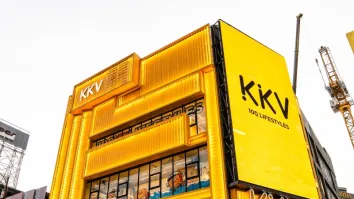
Finding the right balance: Michelle Evans guides retailers in the course of rapid digital transformation
According to Euromonitor's Senior Head of Global Digital Consumer Research, the digital revolution has been rewiring retail for years.
As Senior Head of Global Digital Consumer Research at Euromonitor International, Michelle Evans oversees the firm's digital and retail research, providing actionable insights and in-depth analysis into how technological advances are reshaping the way consumers browse and buy goods and services globally.
She regularly writes and speaks about Euromonitor's research with her specialty spanning mobile payments, digital commerce, e-commerce, m-commerce, digital marketing, and social media. Recognized as a thought leader in the retail industry, she was named a top 100 retail influencer by RETHINK Retail in 2021 and a Woman to Watch by retail social think tank Remodista in 2018 and 2019.
She has shared her expertise across industry events, including the National Retail Federation’s Big Show, Shoptalk, Money 20/20, Finovate, Mobile World Congress, Seamless, and Forum E-Commerce Brasil in the capacity as a speaker, chairperson or juror. Leveraging her master's degree in journalism from Northwestern University, she has a recurring column in Forbes and is regularly quoted in publications globally.
As one of the judges for Retail Asia Awards 2021, we recently sat down with Michelle as she shared with us some of her insights about new business models in retail, digitalisation and consumer brand engagement, shifts in consumer behaviour, and Euromonitor’s forecast about e-commerce before the COVID-19 pandemic.
What are the most important retail stores emerging in Southeast Asia?
Southeast Asia is one of the most promising regions to watch for e-commerce growth as these consumers continue to access more goods and services online. In particular, Indonesia saw the greatest jump of any country in the world in terms of the share of goods bought via e-commerce in 2020.
A few factors helped to support this surge: the growing middle-class population, high internet penetration, the expansion of alternative financing, and the growing reach of digital marketplaces. These factors helped Indonesia to bridge the gap between supply and demand for products during the crisis. With shopping centres closed due to large-scale social restrictions in Indonesia, retailers shifted online to generate income. At the same time, consumers became more willing to buy products online, including essential ones like food. All product categories saw a significant online shift, with food and drink, consumer health and pet care each posting a triple-digit growth rate.
Small businesses also came online in greater numbers, leveraging the low start-up and operational costs of digital in comparison to physical stores. Marketplaces play a key role in Indonesia’s retail sector, accounting for 75% of product-based e-commerce in 2020, up from only 21% in 2015. This expanding business model is important because, as an archipelago made up of over 17,000 islands, retail is highly localised, with smaller independent stores dominating. Marketplaces often offer services to their merchants, including payment, fulfilment, and delivery support, to ease the process of selling online.
How have technological advances changed the retail industry?
The digital revolution has been rewiring retail for years, leading to new business models, commerce ecosystems, and channels for reaching and engaging consumers. The COVID-19 pandemic accelerated this transition, as e-commerce became the default option for many homebound consumers.
Even before COVID-19 became a global pandemic, Euromonitor International had forecast that e-commerce would become the largest channel globally in 2020. Although the continued growth of e-commerce was likely to be a headline story in 2020, the intensity of the health crisis accelerated its development. The crisis-inspired surge in e-commerce is causing a permanent shift in retail, creating both new challenges as well as new opportunities for retailers and consumer brands alike.
Over the 2020-2025 forecast period, e-commerce is expected to account for more than half of the absolute value growth in the global retail market. To put that projected e-commerce growth in context, absolute value growth would be roughly the size of the total value of products sold across all retail channels just five years ago.
Digitalisation is also having a major impact on consumer-brand engagement. Consumers turned to digital channels in greater frequency during the crisis to engage with brands, leading to the rise of virtual engagement and live selling. This is likely to have a lasting effect on this relationship as the online channel becomes more prominent for all steps of the path to purchase.
How can retailers find the right balance between driving their current business and adapting themselves for future growth?
As COVID-19 became a global pandemic, retailers were suddenly operating in a “new normal”, forcing them to rethink their day-to-day operations and even their long-term strategies.
Retailers adjusted business practices to keep employees and consumers safe. They screened for the sick by taking temperatures at entrances. They limited the number of people in stores, added markers to floors to encourage social distancing, installed sneeze guards at checkouts and reduced traffic to one direction in aisles.
Quick-thinking companies pivoted to better serve consumers as they shunned physical outlets. As an example, retailers and shopping centre operators ramped up kerbside pick-up operations. Consumer brands also explored new channels or launched direct-to-consumer operations.
Although COVID-19 inspired new consumer behaviours, forcing companies to revisit their short-term planning, in many ways the crisis accelerated digital trends that were already in motion, including the new era of contactless retail, propelling virtual to become mainstream and forcing a rethink of last mile operations.
The expanding influence of tech will be one of the most pronounced long-term impacts of the global pandemic. Technology will play a pivotal role as it can be used to enhance the entire commerce lifecycle from improving operational efficiencies to elevating the consumer experience.
Retailers and consumer brands who were not investing or more broadly adopting a digital-first mindset pre-crisis have fallen that much further behind their peers. Do nothing and they risk alienating their consumer base, which is likely to have become much more digital-savvy during this period of rapid digital transformation.
How has consumer behaviour and spending changed before and during the pandemic? Do you think this will significantly change after the pandemic is over?
With physical outlets closed during the height of outbreaks, consumers had little choice but to turn to the digital channel to obtain goods and services. These shifts brought several consumers online for the first time, permanently widening the pool of shoppers, and led existing e-commerce users to increase their online shopping frequency.
Besides shopping more in already familiar categories, consumers turned to the online channel across a broader range of products and services. Products that consumers once shied away from buying online made inroads.
The percentage of minimal online shoppers – connected consumers who did not use digital during the research and purchase steps in the consumer journey or only used digital to shop for one category – dropped significantly between the early 2020 and late March fielding timeframes. In turn, there was a sharp rise in the number of heavy online shoppers, who shopped across four or five of the categories explored in this analysis.
These shifts in consumer behaviour largely remained the same in early 2021. While consumers will undoubtedly return to stores to shop once safety concerns subside, the lengthy duration of the crisis has only further reinforced this increased comfortability with online shopping as a long-term behavioural shift.



















 Advertise
Advertise





